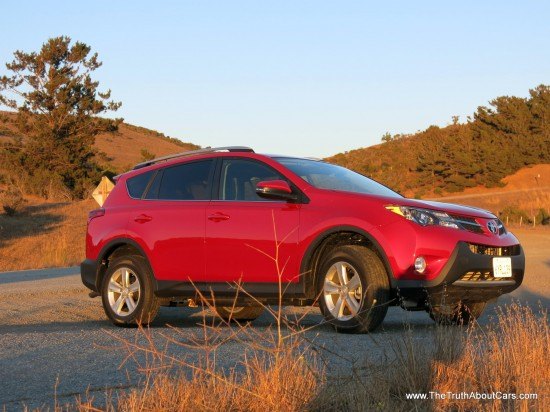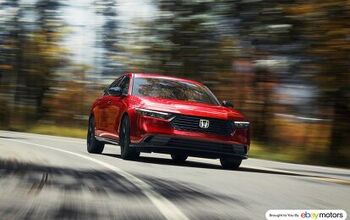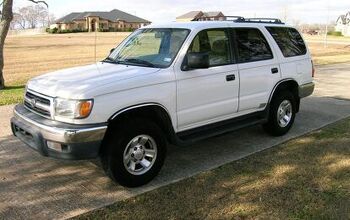Review: 2014 Toyota RAV4 (With Video)

When the RAV4 landed, I wasn’t sure what to make of it. In a world of unified corporate identity the RAv4 goes off script with a look all to its own. While the old RAV sold on mini-truck looks, the new one is undisguised crossover. The new nose has grown on me slightly since I recorded the video above, but I still find the look a little awkward. Since I was scolded for wearing striped pants with a striped shirt the week I tested the RAV4, feel free take my style opinion with a grain of salt as you click through the jump.
Exterior
The RAV4’s cargo hold has one of the lowest lift-over heights for loading in the compact crossover segment. While this makes loading easier, it means the hatch is closer to the ground and makes opening it more awkward. I thought I was alone, but some of our Facebook friends commented that the hatch hit them in the abdomen if they didn’t take a large step backwards when opening it.
Interior
The RAV4’s interior is a sea of shapes, not all of which jive with one another. It’s as if the engineers couldn’t decide which styling direction to take, so they gave the interior a bit of everything. On the flip side, the majority of the cabin materials are above the likes of the Kia Sportage. The stitched pleather pieces of the dash help bring the cabin up-market but the urethane steering wheel lets the cabin back down. The carbon-fiber looking plastic trim seems to scratch easily as well and it’s located in high-traffic areas like the cupholder surround and by the window switches. This dichotomy is unique to the RAV4 with rest of the competition being uniform in terms of style, quality and feel. On average the RAV4 is in the upper-middle of the pack, but this double personality leads people to see what they want to see in the interior.
Front seat comfort is merely average in the RAV4 thanks to seats that lack adjustable lumbar support or a power adjustment mechanism. Continuing Toyota’s move away from leather, the Limited model gets SofTex faux-moo instead. Out back, the big change is the lack of a third row option for 2014. Toyota tells us that the take rate was low with most 7-seat shoppers opting to step up to the Highlander. The loss of the extra seats should have given Toyota a bit of room to expand the second row but it has actually shrunk for 2014 by one inch and the rear seats have lost their ability to slide forward/backward. Cargo room slots in at a massive 38.4 cubic feet jumping to 73.4 if you fold the rear seats flat, well above the competition.
Infotainment
The current touchscreen unit includes standard Bluetooth and a backup camera in addition to the usual combination of AM/FM and a single slot CD player. The standard 6-speaker audio system is moderately well balanced for a compact crossover. The system is easy to use and offers full voice command of your USB/iDevice media library. Optional on the XLE and Limited models is Entune smartphone app integration and flash-disk based navigation. The nav system is intuitive and easy to use but the system’s screen is easily washed out in strong daylight. Although the system is intuitive and highly functional, Entune is outclassed by the larger touchscreen products in the Ford Escape, GMC Terrain, Kia Sportage and the new Jeep Cherokee to name a few.
Drivetrain
For $1,400 Toyota will toss in their full-time AWD system on any trim level. The RAV4’s AWD system follows the same formula as the rest with a multi-plate coupling acting as a quasi center differential. This system is somewhat unusual however because the driver can lock the coupling on demand via a button in the dash. Although the lock will self-disengage over 25MPH, only the Jeep crossovers offer a similar touch. Engaging the car’s “sport” mode alters the throttle mapping, transmission shift points and encourages the coupling to lock more frequently to try and limit the FWD nature of the RAV.
Drive
The loss of the V6 is a big blow to the RAV4. In our tests, the RAV4 ran from 0-60 in 8.64 seconds in AWD trim, faster than the CR-V but slightly slower than the 2.5L CX-5. If you want anything other than middling performance, you’ll need to drop by the Chevy or GMC dealer for a 301HP Terrain or Equinox.
When the going got twisty, the FWD RAV4 we borrowed from a dealer proved to be competent but not exceptional. Like most crossovers the RAV is softly sprung and exhibits plenty of body roll, tip and dive but it never felt sloppy. Toyota’s structural improvements are noticeable with the rear hatch no longer creaking on uneven driveways. Adding AWD improved the RAV4’s dynamics thanks to software that is programmed to send power to the rear wheels when driving aggressively or when in Sport mode. The system not only prevents the few hints of torque steer the FWD model exhibits, but it also makes the RAV4 more dynamic on the road. Regardless of the model, the steering lacks the precision of the Mazda or Ford, possibly due to the RAV’s higher profile tires but it does rank above the CR-V. If handling is important to you, the Mazda CX-5 is quite simply the best small crossover on the market right now.
Toyota has a history of playing to the “meat” of every segment. Rarely does Toyota build anything extreme, be it the cheapest car in its class, the most expensive, fastest, slowest, etc. That describes the RAV4 to a tee. After a week with the RAV4 I wasn’t offended but neither was I enraptured. Toyota’s trucklet is reasonably priced ranging from $23,300-$28,410 and in most trims represents a decent (but not extreme) value compared to the competition. Yes, the CX-5 is more exciting, but like the more luxurious and gadget-rich Escape, it’ll cost you more. The CR-V is quieter but it’s also a few bucks more expensive. The Cherokee is more off-road capable but Chrysler’s reliability reputation isn’t exactly stellar. The Forester is the better choice for wagon lovers and the Sportage and Escape have powerful turbo options that speak to my heart. The GMC Terrain and Chevy Equinox have been refreshed and feature 301 horsepower mills for those that like to count ponies and an infotainment system that’s more attractive than Entune.
The new RAV is, without a doubt, a better 2-row crossover than the model it replaces. It’s also a very pragmatic choice delivering a blend of good fuel economy, large cargo hold, an AWD system that’s more capable than most in the segment and, being a Toyota, it’s likely to have a good reliability record as well. The 2014 RAV4 is a solid crossover and you can’t go wrong by putting one in your driveway. If however you want my advice, and since you’re reading this I assume you do, check out the CX-5 and Escape before you sign on the dotted line.
Toyota provided the vehicle, insurance and and one tank of gas for this review.
Specifications as tested
0-30: 3.17 Seconds
0-60: 8.64 Seconds
1/4 Mile: 16.88 Seconds @ 82 MPH
Sound Level at 50 MPH: 68db
Average Fuel Economy: 25 MPG over 483 Miles

More by Alex L. Dykes
Latest Car Reviews
Read moreLatest Product Reviews
Read moreRecent Comments
- Probert They already have hybrids, but these won't ever be them as they are built on the modular E-GMP skateboard.
- Justin You guys still looking for that sportbak? I just saw one on the Facebook marketplace in Arizona
- 28-Cars-Later I cannot remember what happens now, but there are whiteblocks in this period which develop a "tick" like sound which indicates they are toast (maybe head gasket?). Ten or so years ago I looked at an '03 or '04 S60 (I forget why) and I brought my Volvo indy along to tell me if it was worth my time - it ticked and that's when I learned this. This XC90 is probably worth about $300 as it sits, not kidding, and it will cost you conservatively $2500 for an engine swap (all the ones I see on car-part.com have north of 130K miles starting at $1,100 and that's not including freight to a shop, shop labor, other internals to do such as timing belt while engine out etc).
- 28-Cars-Later Ford reported it lost $132,000 for each of its 10,000 electric vehicles sold in the first quarter of 2024, according to CNN. The sales were down 20 percent from the first quarter of 2023 and would “drag down earnings for the company overall.”The losses include “hundreds of millions being spent on research and development of the next generation of EVs for Ford. Those investments are years away from paying off.” [if they ever are recouped] Ford is the only major carmaker breaking out EV numbers by themselves. But other marques likely suffer similar losses. https://www.zerohedge.com/political/fords-120000-loss-vehicle-shows-california-ev-goals-are-impossible Given these facts, how did Tesla ever produce anything in volume let alone profit?
- AZFelix Let's forego all of this dilly-dallying with autonomous cars and cut right to the chase and the only real solution.



























































Comments
Join the conversation
This is absoluting the worst CUV for strutural noise and resonance. Granted I've never driven it but just closint the door door sent a reverberating humming and quivering noise that lasted the longest of any of the CUVs at the autoshow this year. It was so bad that I opened and closed the door almost five times as I could believe what my ears were hearing. I cannot fathom how this echo chamber sounds like on a rough road.
Note that the seats on both the XLE and Limited have "sport bolsters". They make the seats feel quite narrow. Sales people, and this review, do not mention this difference.